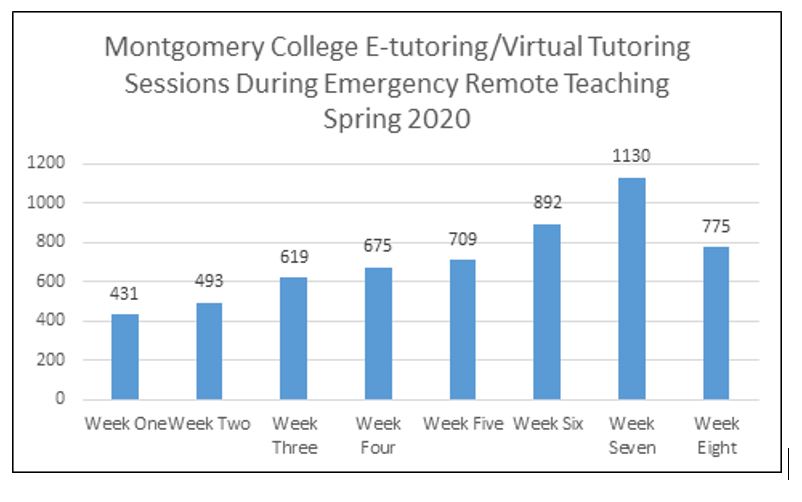A Sense of Normalcy in a Difficult Time: A Renewed Spirit of Collaboration Provides Virtual Academic Support at Montgomery College
By Dr. Lucinda Grinnell, Acting Manager WRLC, Rockville , Tanya Camp, Manager WRLC, Takoma Park/Silver Spring , Dr. Elysse Meredith, Manager WRLC, Germantown , Dr. Elizabeth Benton, Professor of English, Rockville
When COVID-19 forced a shift to emergency remote learning, our team of learning center managers utilized every second of those first couple of weeks to evaluate and adjust the way we provide academic support to Montgomery College students. The emergency transition to remote learning put our team to the test, demanding of us to make thorough, unified, and swift decisions that would provide continuity of practice to thousands of students who had grown accustomed to our brick and mortar space and support. As we reflect on these past months, we see that prior to COVID-19 we had laid the groundwork for effective and collaborative decision-making. First, we had a shared mission statement:
Montgomery College Learning Centers promote student success by providing engaging, responsive, and interactive academic support. Through high quality professional tutoring and collaborative collegewide services, the Centers’ dedicated and caring staff fosters a welcoming and empowering learning environment for a diverse student body.
In addition, despite our varied responsibilities to students and disciplines, we had camaraderie and efficient organization. As a result, we are able to continue to evolve, to innovate, and to provide high quality and varied tutoring and support. Moreover, we feel stronger as a unified team than we have in years. Despite Zoom glitches and personal and professional challenges, we describe in this article some hurdles we’ve overcome as a team, the help we’ve provided to students, and the vision we have for a robust virtual learning environment that forefronts student academic support in new ways.
Collaboration before Emergency Remote Teaching Guided our Path
Before the pandemic, all learning center managers met monthly to meet the demands of our shared mission and goals and those of the Montgomery College community. For the past three years, our annual report has guided our work in key areas: access to academic support, engagement through innovation, community building through academic support partnerships, and self-efficacy and inclusion through innovation. We also leaned into Goal II from the Montgomery College 2025 Strategic Plan: to share, plan, and coordinate services and programming, with a particular focus on “implement[ing] optimal and inclusive learning and teaching environments so that all students feel welcomed and empowered to succeed.” With our mission and goals in mind, we had already studied and implemented innovative, online tutoring and supplemental course material development. All of the Writing, Reading and Language Centers, as well as the Academic Success Center, have provided virtual tutoring for quite some time. We decided, therefore, to drill a little more deeply into numerous examples of the online resources that centers can develop to support students (Hewett, 2015; Khalifa, 2018; Mackiewicz & Babcock, 2019; Mackiewicz & Thompson, 2018; Paiz, 2018; Stroble, 2015). Paiz (2018) suggests rightly that writing centers can be the face of the college, “carrying out essential identity and engagement work” of the institution (p. 4). As such, colleges whose learning centers offer vibrant face-to-face and online resources can benefit populations—beyond students, staff, faculty, and administrators who frequent the hallways and classrooms—serving as a touchstone for the college. We knew we could meet the challenges of a new learning center paradigm, but it would take a shift in mindset and even more frequent communication than before. We were confident we could support students virtually, but we had to be courageous and vulnerable (Brown, 2018).
Swift and Sustained Action to Emergency Remote Student Support
Days before we closed campus doors and opened virtual ones, a subcommittee of learning center managers proposed a solution to collaborative virtual tutoring that could reduce confusion for students. Faster than you can say “student success” each manager had agreed to take on various roles:
- redesign the website;
- use WCONLINE, the platform traditionally used for WRLCs only, for all centers;
- provide training for learning center staff members who would now be using WCOnline for the first time;
- draft a unified syllabus statement, providing guidance on our virtual services to faculty and students;
- convene the learning center manager team biweekly;
- reach out to social media more frequently to get blasts out to students, including a video for students about virtual services;
- build community with ATPA for summer shared professional learning around coaching and tutoring;
- create and update YouTube videos for faculty, staff and students;
- share our message of access, inclusion, and equity via department meetings, college-wide chair meetings, and campus leadership meetings;
- create a shared inbox to help students: LearningCenters@montgomerycollege.edu
Despite being socially distanced, no center manager had to feel or be alone in continuing to support students.
A Look at Virtual Tutoring
During our early decision-making process, learning center managers discussed both asynchronous “eTutoring” (where students do not speak directly to the tutor) and synchronous “online tutoring” (where students speak directly to the tutor). Both synchronous and asynchronous tutoring meet student needs in different ways. Beth Hewett, who has written extensively on virtual tutoring pedagogy, addresses the advantages of asynchronous tutoring and feedback:
- Asynchronous tutoring provides students the opportunity to receive feedback without taking time out of their often too-full schedules.
- Asynchronous tutoring affords tutors time to engage in the writing process, carefully review documents, and produce thoughtful feedback; students can later refer to this feedback because it exists in a permanent state.
- Asynchronous tutoring proffers a sense of privacy that may otherwise be absent in a face-to-face interaction (Hewett, 2015, p. 43).
Early into emergency remote instruction, asynchronous tutoring (“eTutoring”) served students well. As we continue to study our own practices, we find that students and tutors value the time they have during synchronous tutoring sessions. More and more, students have leaned on synchronous sessions to gain clarity about assignments and a professor’s feedback on writing. Students work with WRLC tutors on brainstorming and outlining, critical pieces to their writing and learning process. Students work with STEM tutors on gaining foundational and advanced skills required for their STEM course work. As we continue to learn best practices around virtual tutoring, we have expanded the types of services we provide, each center meeting the diverse demands of the disciplines we serve.
Check out the the eTutoring video for students: https://youtu.be/Si3aOopMmnk
Students Respond Positively to Virtual Tutoring
During just the second week of virtual tutoring at the Rockville WRLC, one faculty tutor received a “thank you” email from a student. The student expressed that they had not realized how “helpful” eTutoring would be. The student wrote, “I sent my essay draft through eTutoring to you, and I just wanted to say that your feedback was extremely helpful. I can even say that I have never gotten feedback that is this clear. Thank you so much!”
Similarly, tutors who had been nervous about working remotely began to see the benefits to students. Lisa Nevans-Locke, English part-time faculty and tutor at the Takoma Park/Silver Spring WRLC, had this reflection:
Virtual tutoring allowed students to stay connected even when we were not together on campus. While we [teachers] couldn’t provide the same support in a Zoom or Blackboard Collaborate classroom, students could still get that crucial one-on-one help at the WRLC. More than anything, I think the Writing, Reading, and Language Centers provided students with a sense of normalcy in a difficult time. It was a place where they could seek out a familiar face at a time that was convenient for the student.
Both the quote from the student and the tutor exemplify the positive impact virtual tutoring can have on student learning in a remote  environment.
environment.
A Snapshot of the Data
Prior to COVID-19, our campus-based learning centers served thousands of students each semester. During an average face-to-face semester, we see upwards of 19,000 tutoring sessions and countless more “student logins,” (centers provide an array of support to students, including models and resources that support classroom instruction, computers, printers, software, quiet space, and space for group study and/or projects). In order to assess our progress during COVID-19, we looked back at tutoring sessions and workshop participation during spring 2019. From March 23- May 31, 2019, we saw over 9,000 logins for tutoring sessions and/or workshop participation, ranging from 30 minutes to several hours. Despite moving to a virtual-only paradigm in late March 2020, our data collection on tutoring sessions and workshop participation from March 23- May 31, 2020, shows that we saw over 7,110 logins limited to 45 minutes to one hour. Here’s what is interesting that makes spring 2020 virtual tutoring feel like it had an extremely positive impact on students: To crunch the numbers a bit more, we studied the data based on 30-minute to 90-minute tutoring sessions and workshop participation between March 23 and May 31. When comparing spring 2019 tutoring sessions and workshop participation
lasting 30 to 90-minutes to spring 2020 tutoring sessions and workshop participation lasting 45 minutes, we see higher spring 2020 session numbers by roughly 1,000 sessions (see Table 1).
Table 1. Spring Tutoring Sessions and Workshop Participation 2019 and 2020
| Spring Semester | Tutoring Sessions and Workshop Participation |
| Spring Data 2020
|
7,110
45-minute tutoring sessions and workshop participation available March 23 through May 31 |
| Spring Data 2019
|
6,016
30-minute to 90-minute tutoring sessions and workshop participation March 23 through May 31 |
Considering factors such as requisite technological adjustments and the countless barriers students face (not to mention professional training tutors and staff underwent at warp speed), we see the thousands of sessions we provided as a victory for student success.
We have only begun to understand the data of COVID-19 and emergency remote learning, but we are affirmed that so many tutoring sessions occurred. When students needed support, our team’s nimble mindset and innovative action provided hours of support that many students would have been lost without. (See Figure 1. Montgomery College E-tutoring/Virtual Tutoring Sessions during Emergency Remote Teaching Spring 2020)
Figure 1.
Thinking Outside the Box for Academic Year 2021
The lessons we learned while managing the centers, holding virtual workshops, and conducting tutoring sessions remotely will continue to influence how we work with students. In the fall, virtual tutoring is already expanding, and we are sharpening our focus in the following ways:
- continue biweekly meetings to maintain collaboration and consistency;
- create two systems, WCOnline for WRLCs and STEM WCOnline for STEM learning centers;
- revise virtual tutoring webpage, allowing for faster service and fewer searches;
- provide one-stop support through LearningCenters@montgomerycollege.edu;
- create virtual orientations, both synchronous (a center employee goes “into” the classroom) and asynchronous (a video tutorial);
- host writing studios for students so they can engage with peers;
- lead professional development opportunities for tutors that focus on wellness during the pandemic;
- design programs for tutors and students to highlight equitable and inclusive practices, guided by learning center managers who serve on the President’s Advisory Committee for Equity and Inclusion (PACEI)
- continue our summer professional development program for ATPA coaches and tutors.
As a team, we’ve joined hearts and minds to consider how we can provide a virtual space that meets students where they are. Whether students are enrolled in structured remote learning, enrolled in distance learning, or are busy with family, work, and other constraints, we will be here for them. Through continued collaborations and “outside the box” strategies, we will provide the support students need to achieve their academic and career goals.
References
Brown, B. (2018). Dare to Lead: Brave Work. Tough Conversations. Whole Hearts. Random House.
Hewett, B. (2015). The online writing conference: A guide for teachers and tutors. Bedford/St. Martin’s.
Khalifa, M. A. (2018). Culturally responsive school leadership (Vol. 217). Cambridge, MA: Harvard Education Press.
Mackiewicz, J., & Babcock, R. (Eds.). (2019). Theories and methods of writing center studies: A practical guide. Routledge.
Mackiewicz, J., & Thompson, I. (2018). Talk about writing: The tutoring strategies of experienced writing center tutors. Routledge.
Montgomery College Strategic Plan 2025 Committee (2019). Montgomery College Strategic Plan 2025. Internal report: Unpublished.
Paiz, J. (2018). Expanding the writing center: A theoretical and practical toolkit for starting an online writing lab. TESL-EJ. 21. 1-19.
Stroble, E. B. J. (2015). Stories to tell and years to celebrate. Women in Higher Education, 24(1), 8-19.



